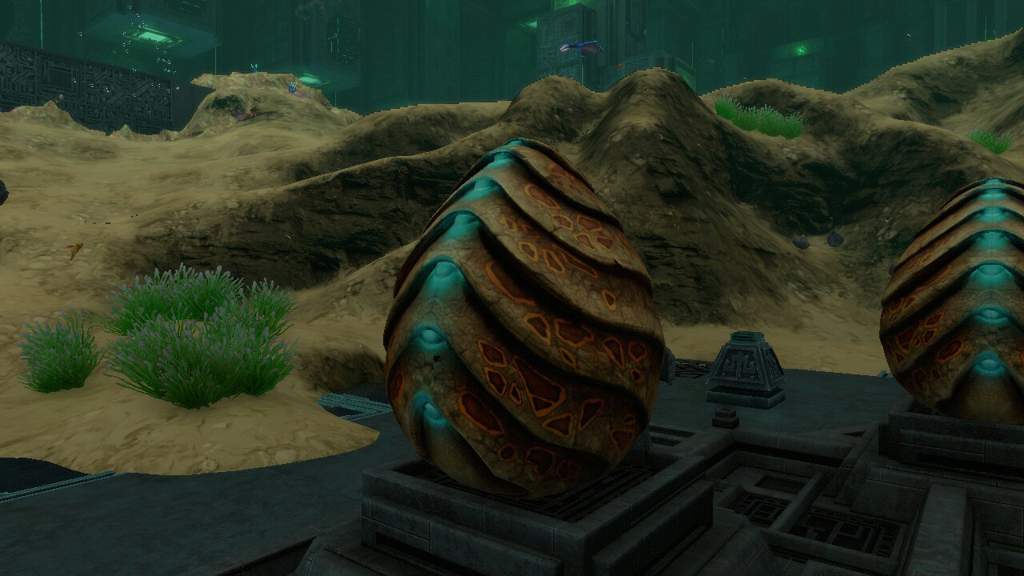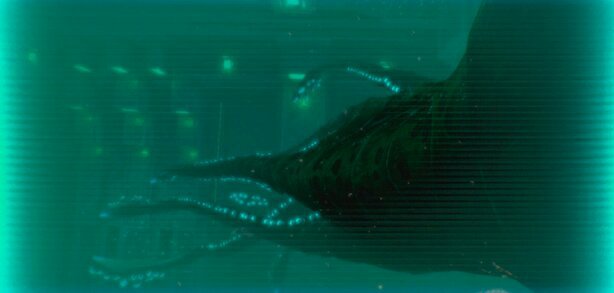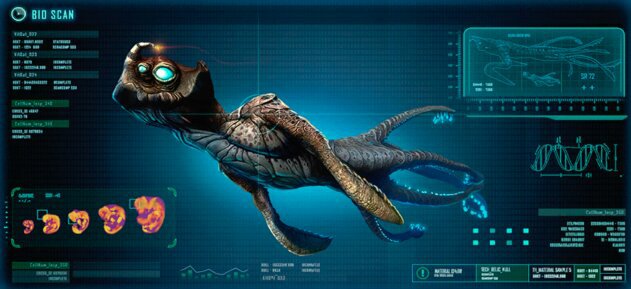what to do after hatching the Sea Emperor Babies
══════════════════════════
│SPOILER│
══════════════════════════
Yes.. you're not supposed to click on this wiki if yous don't want some story spoilers.
General Description
The Sea Emperor Leviathan is a colossal, leviathan grade species, with the longest that has ever been recorded at a staggering 160 - 200 m. It is also the biggest living animate being encountered in the planet. Fortunately, its diet is consist of microscopic creatures - planktons and the like. The most important matter to know nearly sea emperor leviathan is its capability of producing enzyme 42, an enzyme capable of inhibiting the kharaa infection.
Appearance
Sea Emperor Leviathan has almost the same torso figure as the Sea Dragon Leviathan. Information technology has 7 tentacles at the cease of its body, help to propel its big torso across the ocean. Instead of webbed claws, Ocean Emperor has sea turtle-like paddles. Sea Emperor head is shaped hammerhead-like with 2 yellow luminescent-tipped antennas. It has two pair of lite blue eyes and a mouth in betwixt two mandibles.

Bioluminescent
Behaviour
Not much is known well-nigh the Sea Emperor, too the information the Annual race provides us with. As stated earlier, bounding main emperor leviathan species is planktivore, exclusively eats microscopic brute. They move in small herds around ocean trenches, only coming to the surface to feed off huge volumes of microorganisms. They produce enzyme 42 within its stomach cavity to break downwardly their food and will occasionally miscarry it into surrounding waters. Even then, there'southward no prove to support the assumption that all members of this species were immune from the leaner. Although the emperor constitute in the containment facility was 1600 years old, it actually lived longer than the peak lifespan for its species.

Its trounce casing is formed from thick layers of carbon-composite, suggesting an extensive gestation flow.
In their normal life cycle, mating and egg-laying are probable infrequent. Sea emperor leviathans may give nativity once in a century, or peradventure once in their lifetimes. Furthermore, they have preferred egg-laying environs, too as their eggs' hatching conditions. Afterward the extensive gestation period, they bury their eggs in shallow waters, where dissimilar organic materials in the soil will trigger a hatching response (based on the hatching enzyme recipe, these organic materials would be eye stalk, tree mushroom, ghost weed, sea crown, and seedling bush). The presence of these eggs' parents are also essential for their hatching conditions. At a young age, their offspring separate off to class their ain herds elsewhere.
Body of water Emperor Leviathan Research Information

SPECIMEN SIZE CATEGORIES HAVE BEEN ADJUSTED Upward TO Suit THIS SPECIES
1. Feeding & Digestion
Alien research data indicates that despite its size this species feeds entirely on microorganisms it filters from the water, which themselves depend on a complicated ecosystem of plant and animate being life.
2. Reproduction
Large, ovary-like organs are carried in the brute's middle section, suggesting that like other species on this planet it produces eggs, even so internal scar tissue indicates likely infertility.
3. Enzyme 42
The emperor manufactures Enzyme 42 inside its stomach cavity to break downwardly its nutrient, and will occasionally expel it into the surrounding waters. This substance was institute to neutralize the effects of the bacterium, and its presence in the ecosystem today would explain how life on the planet survived the outbreak. It would remain to exist explained by what mechanism the enzyme is beingness delivered.
four. Health
Comparative analysis of size and metabolic rates indicates the specimen captured by the researchers was approximately one,600 years one-time. Extensive internal and external scar tissue suggest information technology had lived well in backlog of the tiptop lifespan for its species.
Cess: While a salubrious emperor specimen may have held some potential equally a cure, it is unlikely whatever research subjects survived quarantine procedures.
The Bounding main Emperor's Lifecycle
Available biological data has been used to synthesize the effects of the alien bacterium on the body of water emperor's natural lifecycle.
This brute likely lived and moved in pocket-sized herds around the planet's ocean trenches, coming to the surface to feed off the huge volumes of microorganisms in the shallower waters. Family size would be strictly limited by available food supply. Offspring would likely carve up off at a young age to grade their own herds elsewhere.
Given their sparse population, mating and egg-laying were likely infrequent, possibly a once in a lifetime event. The species likely had a preferred environment for egg-laying - in fact successful hatching may depend on such conditions. Given the rarity of this event, it is impossible to calculate those atmospheric condition precisely.
There is no evidence to support the supposition that all members of the species were immune from the alien bacterium. Fifty-fifty if this is and so, there is evidence that introduction of the bacterium decimated life on the planet, and this would have had catastrophic effects on the emperors' food supply and survival charge per unit.
The symbiotic human relationship between this specimen and other lifeforms likely adult as a direct outcome of the bacterial infection. Those lifeforms which learned to keep the emperor alive survived with its help. This may explicate the vast tracts of lifeless sea in a rough perimeter around the emperor's location.
Bounding main Emperor Juvenile Database

A juvenile emperor specimen. Information technology is producing a highly potent grade of Enzyme 42, which should be capable of fully curing individuals of the alien bacterium.
This species hatches relatively fully formed and independent, possibly reflecting the fact they must fend for themselves when they are first born away from their parents.
This specimen is healthy, and exhibiting signs of a positive attitude to life.
Trivia
1. Early concept art of Sea Emperor Leviathan has large claws, instead of paddle-like limbs.
2. Sea emperor leviathan'south dialogue indicates that the Almanac may not exist able to hear its telepathy.
3. There are some developmental documents that refer to Sea Emperor equally 'Thousand Leviathan'.
four. Indicated by one of its databank entry, Bounding main Emperor Leviathan is the largest identified species in the universe.
v. Three of Sea Emperor Leviathan juveniles are found in Sector Zero, the area of Below Zip.
══════════════════════════
│END OF SPOILER│
══════════════════════════
------------------------------------------------
Sea Emperor Leviathan Source
Sea Emperor Leviathan Juvenile Source
Sea Emperor Leviathan Baby Source
P.Southward. If there's anything yous'd like me to change or add, merely tell me on the comment section below.
Source: https://aminoapps.com/c/subnautica_official/page/item/sea-emperor-leviathan/lXme_Q80hGIe54RjY6LvbG4nrG3B0XY4o5V
0 Response to "what to do after hatching the Sea Emperor Babies"
Post a Comment